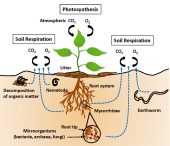"Let the soil work for us" free online article at Cyber-Help for Organic Farmers
http://www.certifiedorganic.bc.ca/rcbtoa/training/soil-article.html Let the soil work for us
Elliott, E. T. and Coleman, D. C. 1988. Let the soil work for us. - Ecol. Bull. 39: 23-32. Reprinted with Ecological Bulletin permission.
Appropriate management of microbial populations in soil can reduce leakage of excess nutrients from the rooting zone and enhance the fertilizer use efficiency and agroecosystem production. Manipulation of the microbial habitat by varying residue and tillage management is an effective and practicable way to manage soil microorganisms. Aggregation, pore space and preferential flow are strongly influenced by cultivation. The architecture of the soil structure can determine the habitability for soil microorganisms and nutrient fluxes through agroecosystems. Soil organic matter availability to microorganisms is related to its position within the soil matrix. A simple hierarchical model for soil aggregation can explain many aspects of changes in soil organic matter aggradation and degradation. Likewise, four hierarchical pore categories are presented which relate to the aggregate structure of the soil and provide a basis for predicting how soil pore networks influence ecological relationships among organisms in soil detrital food webs. Macroporosity is sensitive to variations in cultivation practices and can increase under no-till management. Less leaching of nitrate was observed in no-till experimental plots. This was related to increased infiltration rates and preferential flow of incoming nitrate free rain water down large pores; this effectively bypasses or short circuits the nitrate in the surface soil layers. Where soils were tilled, the water moved down the profile more slowly and subsequently transported more nitrate deeper. Greater macroporosity and a responsive microbial community can be used to provide more efficient management of agroecosystems. Establishment of a new steady state for soils put under no-till cultivation may take as long as a decade in temperate climates.
E. T. Elliott, Natural Resource Ecology Laboratory, Colorado State University, Fort Collins, CO 80523, U.S.A. D. C. Coleman, Dept of Entomology and Institute of Ec









